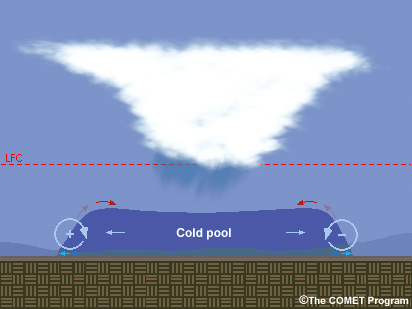Introduction

Vertical wind shear influences storm organization by enhancing the ability of a thunderstorm outflow (or cold pool) to trigger new storms. By itself, a cold pool can only trigger new cells if the upward motion at its leading edge can lift the warm air to its LFC. In a uniform environment, when the vertical wind shear is weak, no one portion of the gust front especially favors new cell growth. Of course, since the atmosphere is generally NOT uniform, there are usually areas along the outflow boundary where lifted warmer air may more easily reach the LFC.
As vertical wind shear increases, the interaction between the shear and the cold pool becomes an additional factor that can enhance the lifting on a preferred storm flank. This enhanced lifting occurs even in a relatively uniform environment. We can describe this shear/cold pool interaction through the concept of horizontal vorticity.
To learn more about the origin of the cold pool, see the module Principles of Convection I: Buoyancy and CAPE.